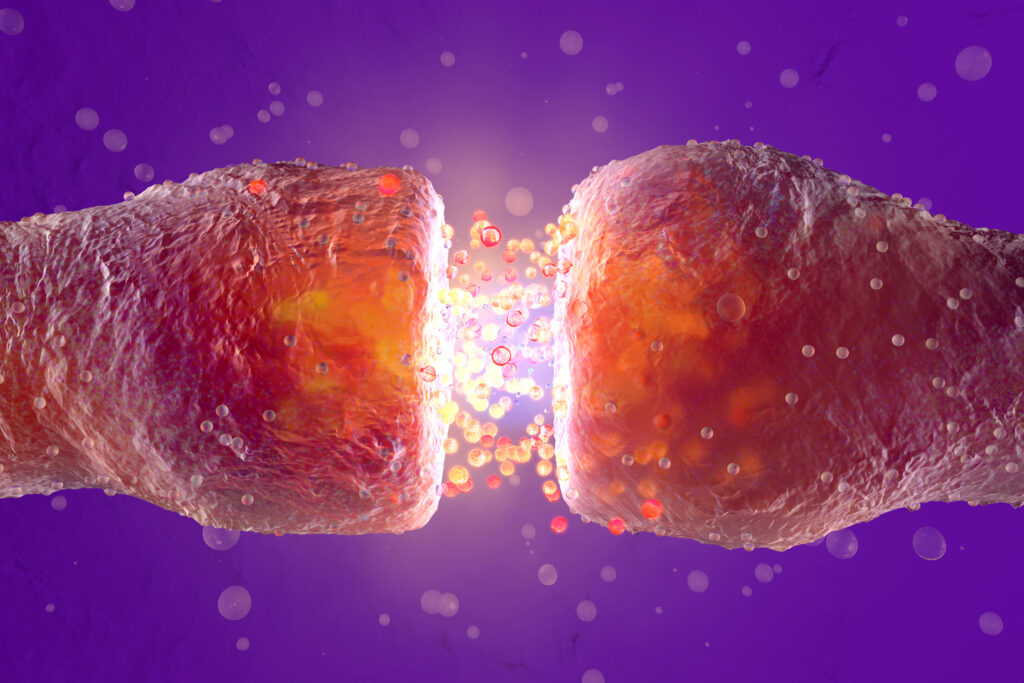A new study from researchers at Northwestern University has described how the TDP-43 protein moves from its normal location in the cell nucleus to the cytoplasm resulting in excessive neuronal firing in amyotrophic lateral sclerosis (ALS) and frontotemporal dementia (FTD). The research, published in Nature Neuroscience, also details the development of a gene-targeting antisense oligonucleotide (ASO) drug which restores normal balance and reduces this overactivity.
In their new work, the Northwestern team discovered that when TDP-43 malfunctions, it causes mis-splicing of the potassium channel gene KCNQ2. Normally, KCNQ2 encodes the Kv7.2 channel, which generates a stabilizing electrical current that acts as a neuronal “brake” to keep neurons from firing too much. Without this, neurons lose that braking ability and become overactive.
“By fixing the KCNQ2 splicing error with the ASO drug, we were able to calm overactive neurons, and restoring neuronal activity could potentially slow disease progression,” said senior author Evangelos Kiskinis, PhD, an associate professor of neuroscience and neurology at Northwestern University Feinberg School of Medicine.
TDP-43 (TAR DNA-binding protein 43) is a nuclear RNA-binding protein that plays diverse roles in RNA metabolism, including regulation of gene expression, RNA splicing, and mRNA stabilization and transport. In nearly all ALS cases and about half of FTD cases, however, the protein moves from the nucleus to the cytoplasm, where it aggregates and loses function. According to the researchers, this loss of nuclear TDP-43 disrupts RNA splicing and causes toxic cellular effects.
“The mis-spliced mRNA escapes degradation and is translated into a nonfunctional protein with severely reduced ion conductance that aggregates in the endoplasmic reticulum and causes intrinsic hyperexcitability in ALS neuronal models,” the researchers wrote in the study’s abstract. When this happens, it results in higher levels of phosphorylated TDP-43 and an earlier onset of disease.
Prior work has implicated TDP-43’s involvement in RNA mis-splicing, linking it to altered processing of other neuronal genes such as STMN2 and UNC13A. But until now, no research had demonstrated how TDP-43 dysfunction could lead to the widespread hyperexcitability of neurons that has been observed in both ALS and FTD. “Our work connects two central features of the disease—TDP-43 pathology and hyperexcitability—into a single mechanistic pathway,” Kiskinis said.
Looking to address this issue, the Northwestern team designed an ASO, a short strand of modified nucleic acid that binds RNA to correct splicing errors. When applied to lab-grown neurons, the ASO restored normal KCNQ2 splicing and reduced neuronal overactivity. The drug, once validated, would be delivered by injection into the central nervous system.
“The mis-splicing of KCNQ2 represents a spurious, TDP-43-dependent event. We observed it in transcriptomes of stem cell-derived spinal-like cholinergic motor neurons and cortical-like glutamatergic neurons in vitro as well as in the spinal cord and motor cortex of tissue from patients with ALS,” the researcher wrote, adding that KCNQ2ΔE5 was absent in neurotypical controls but abundant in ALS and FTD-TDP patient tissue, suggesting it could serve as a molecular biomarker of TDP-43 dysfunction.
The discovery also explains why earlier mouse models of ALS failed to reproduce this aspect of disease biology. The KCNQ2 mis-splicing event is specific to humans and does not occur in rodents.
TDP-43’s normal role as a splicing regulator extends to hundreds of RNA targets in the nervous system, and its depletion has broad effects on neuronal health. “TDP-43 dysfunction yields altered KCNQ2 mRNA that escapes degradation and is translated into a non-functional neoprotein without current conduction capacity that causes inherent hyperexcitability in neurons,” the researchers wrote. This defective channel also interferes with normal Kv7.2 trafficking to the cell membrane, compounding neuronal excitability.
The team’s findings build on previous clinical observations that hyperexcitability predicts faster ALS progression and reduced survival. Current treatments for this include activators of Kv7 channels, such as ezogabine (retigabine), which have been shown to reduce motor neuron excitability in ALS patients, but it is likely this treatment method does not completely counteract the effects of the KCNQ2 variant.
The Kiskinis lab is now working to develop a biomarker test to detect the mis-spliced KCNQ2 RNA in patient samples that could potentially aid in earlier diagnosis, as well as ongoing work to advance their ASO candidate into clinical trials.

